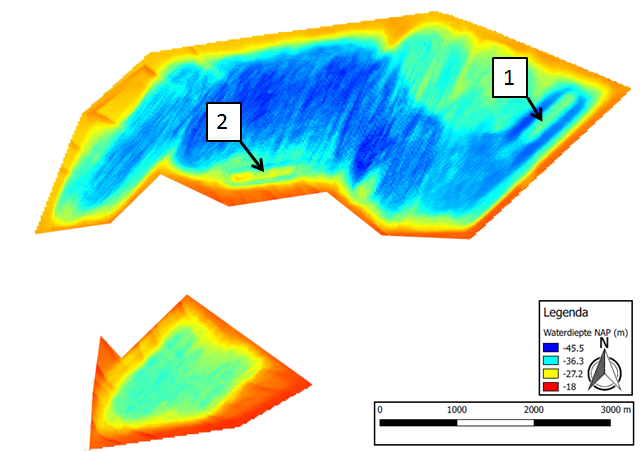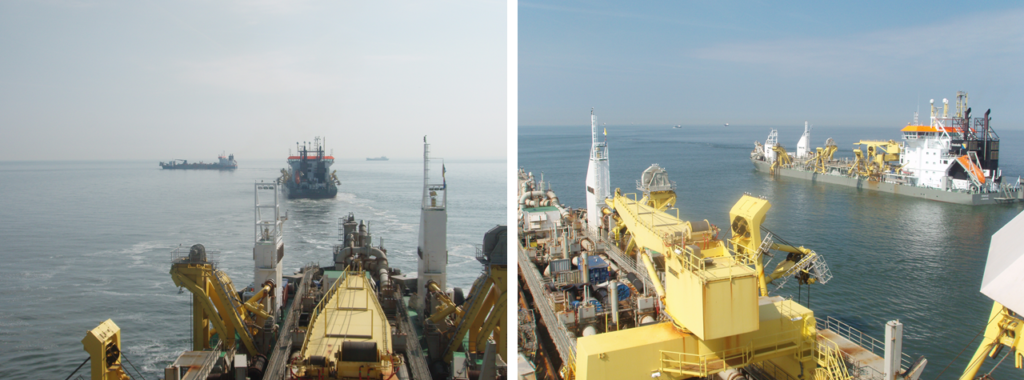Practical Applications
Pilot Ecological sand extraction site
A Building with Nature pilot has been executed in the sand extraction site used for the construction of the Port of Rotterdam harbour enlargement Maasvlakte 2 (MV2). (Ecosystem-oriented Landscaping of Sand Extraction Sites).
The pilot experiment took place in the sand extraction site used for the development of the Port of Rotterdam enlargement ‘Maasvlakte 2’ (MV2). Between 2008 and 2012, 220 million m3 was extracted from a 20-m deep area south of the Euromaasgeul shipping lane. A large northern extraction site is separated by an exclusion area consisting of clay and a southern smaller extraction site.

The Building with Nature pilot ecological sand mining pit involved the realization of two sand bars dredged out the seabed in the 20-m deep sand extraction site which was used for the construction of harbour enlargement Maasvlakte 2 of the Port of Rotterdam (PoR). The effects of deep sand extraction and two ecosystem-based sand bars were studied using a suite of research tools and aligned with the monitoring campaign of PoR to maximise comparable field survey data and to reduce costs.
The effects of deep sand extraction and ecosystem-based landscaped sand bars are monitored after completion for 2-3 years. For scientific output see Ecological landscaping of sand extraction sites, NL.
Focus has been on direct and short-term effects and inter-comparison of effects in the sand extraction pit, on ecosystem-based sand bars and reference areas and investigated infauna (organisms living in the sediment), on epifauna (organisms living on the seabed), on demersal fish (fish living near the seabed) and on sediment characteristics and changes in bathymetry.

Other examples
Outside this Building with Nature application, plenty of examples of similar projects are present.
- Gravel-seeding techniques to restore the seabed to pre-dredge conditions after gravel extraction in the English part of the North Sea (Cooper et al., 2011). Changes in bed shear stress values after sand extraction also the main drivers of ecological changes although not yet fully recognised. Optimisations in bed shear stress values, by finetuning extraction depths and orientations of the sand extraction sites with respect to the tidal current are possible (e.g. to prevent against sedimentation which may be harmful to hatching herring larvae on the gravelly seabed).
- Seine estuary cooperation between dredging and fishing industries (Desprez, 2000; Marchal et al., 2014). Optimisations in bed shear stress values, by finetuning extraction depths and orientations of the sand extraction sites with respect to the tidal current are possible.
- Maximum allowable changes in seabed level and bed shear stress values after sand extraction to maintain original macrozoobenthic characteristics (poster and oral sessions of Koen Degrendele and Dries van den Eynde at the ICES Annual Science Conference 2016)
- Maintenance dredging in river and estuarine systems (Yuill et al., 2016).
- Rijke riffen (van Duren et al., 2016), Building with North Sea Nature: eco-friendly scour protection (Lengkeek et al., 2017) and construction of artificial reefs in Japan (Thierry, 1988).
- Rejuvenation dredging of tidal creeks in a mangrove systems (Bonaire and Curaçao). Pratical Applications, http://www.wur.nl/nl/project/Ecologisch-herstel-mangroven-Lacbaai-Bonaire-van-kennis-naar-pro-actief-beheer.htm
